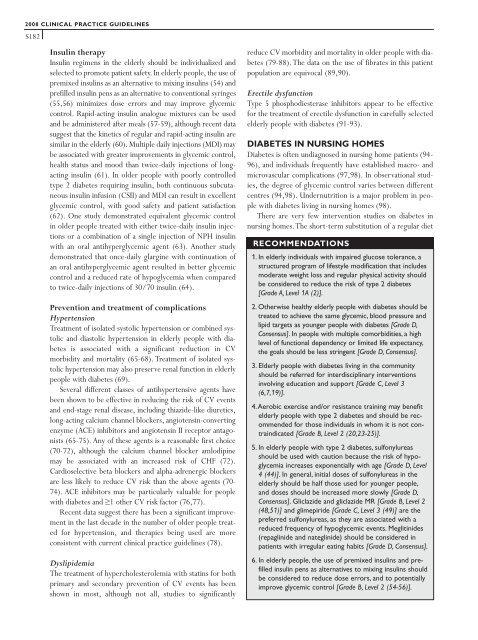2008 Clinical Practice Guidelines - Canadian Diabetes Association
2008 Clinical Practice Guidelines - Canadian Diabetes Association
2008 Clinical Practice Guidelines - Canadian Diabetes Association
You also want an ePaper? Increase the reach of your titles
YUMPU automatically turns print PDFs into web optimized ePapers that Google loves.
<strong>2008</strong> CLINICAL PRACTICE GUIDELINES<br />
S182<br />
Insulin therapy<br />
Insulin regimens in the elderly should be individualized and<br />
selected to promote patient safety. In elderly people, the use of<br />
premixed insulins as an alternative to mixing insulins (54) and<br />
prefilled insulin pens as an alternative to conventional syringes<br />
(55,56) minimizes dose errors and may improve glycemic<br />
control. Rapid-acting insulin analogue mixtures can be used<br />
and be administered after meals (57-59), although recent data<br />
suggest that the kinetics of regular and rapid-acting insulin are<br />
similar in the elderly (60). Multiple daily injections (MDI) may<br />
be associated with greater improvements in glycemic control,<br />
health status and mood than twice-daily injections of longacting<br />
insulin (61). In older people with poorly controlled<br />
type 2 diabetes requiring insulin, both continuous subcutaneous<br />
insulin infusion (CSII) and MDI can result in excellent<br />
glycemic control, with good safety and patient satisfaction<br />
(62). One study demonstrated equivalent glycemic control<br />
in older people treated with either twice-daily insulin injections<br />
or a combination of a single injection of NPH insulin<br />
with an oral antihyperglycemic agent (63). Another study<br />
demonstrated that once-daily glargine with continuation of<br />
an oral antihyperglycemic agent resulted in better glycemic<br />
control and a reduced rate of hypoglycemia when compared<br />
to twice-daily injections of 30/70 insulin (64).<br />
Prevention and treatment of complications<br />
Hypertension<br />
Treatment of isolated systolic hypertension or combined systolic<br />
and diastolic hypertension in elderly people with diabetes<br />
is associated with a significant reduction in CV<br />
morbidity and mortality (65-68). Treatment of isolated systolic<br />
hypertension may also preserve renal function in elderly<br />
people with diabetes (69).<br />
Several different classes of antihypertensive agents have<br />
been shown to be effective in reducing the risk of CV events<br />
and end-stage renal disease, including thiazide-like diuretics,<br />
long-acting calcium channel blockers, angiotensin-converting<br />
enzyme (ACE) inhibitors and angiotensin II receptor antagonists<br />
(65-75). Any of these agents is a reasonable first choice<br />
(70-72), although the calcium channel blocker amlodipine<br />
may be associated with an increased risk of CHF (72).<br />
Cardioselective beta blockers and alpha-adrenergic blockers<br />
are less likely to reduce CV risk than the above agents (70-<br />
74). ACE inhibitors may be particularly valuable for people<br />
with diabetes and ≥1 other CV risk factor (76,77).<br />
Recent data suggest there has been a significant improvement<br />
in the last decade in the number of older people treated<br />
for hypertension, and therapies being used are more<br />
consistent with current clinical practice guidelines (78).<br />
Dyslipidemia<br />
The treatment of hypercholesterolemia with statins for both<br />
primary and secondary prevention of CV events has been<br />
shown in most, although not all, studies to significantly<br />
reduce CV morbidity and mortality in older people with diabetes<br />
(79-88). The data on the use of fibrates in this patient<br />
population are equivocal (89,90).<br />
Erectile dysfunction<br />
Type 5 phosphodiesterase inhibitors appear to be effective<br />
for the treatment of erectile dysfunction in carefully selected<br />
elderly people with diabetes (91-93).<br />
DIABETES IN NURSING HOMES<br />
<strong>Diabetes</strong> is often undiagnosed in nursing home patients (94-<br />
96), and individuals frequently have established macro- and<br />
microvascular complications (97,98). In observational studies,<br />
the degree of glycemic control varies between different<br />
centres (94,98). Undernutrition is a major problem in people<br />
with diabetes living in nursing homes (98).<br />
There are very few intervention studies on diabetes in<br />
nursing homes.The short-term substitution of a regular diet<br />
RECOMMENDATIONS<br />
1. In elderly individuals with impaired glucose tolerance, a<br />
structured program of lifestyle modification that includes<br />
moderate weight loss and regular physical activity should<br />
be considered to reduce the risk of type 2 diabetes<br />
[Grade A, Level 1A (2)].<br />
2. Otherwise healthy elderly people with diabetes should be<br />
treated to achieve the same glycemic, blood pressure and<br />
lipid targets as younger people with diabetes [Grade D,<br />
Consensus]. In people with multiple comorbidities, a high<br />
level of functional dependency or limited life expectancy,<br />
the goals should be less stringent [Grade D, Consensus].<br />
3. Elderly people with diabetes living in the community<br />
should be referred for interdisciplinary interventions<br />
involving education and support [Grade C, Level 3<br />
(6,7,19)].<br />
4.Aerobic exercise and/or resistance training may benefit<br />
elderly people with type 2 diabetes and should be recommended<br />
for those individuals in whom it is not contraindicated<br />
[Grade B, Level 2 (20,23-25)].<br />
5. In elderly people with type 2 diabetes, sulfonylureas<br />
should be used with caution because the risk of hypoglycemia<br />
increases exponentially with age [Grade D, Level<br />
4 (44)]. In general, initial doses of sulfonylureas in the<br />
elderly should be half those used for younger people,<br />
and doses should be increased more slowly [Grade D,<br />
Consensus]. Gliclazide and gliclazide MR [Grade B, Level 2<br />
(48,51)] and glimepiride [Grade C, Level 3 (49)] are the<br />
preferred sulfonylureas, as they are associated with a<br />
reduced frequency of hypoglycemic events. Meglitinides<br />
(repaglinide and nateglinide) should be considered in<br />
patients with irregular eating habits [Grade D, Consensus].<br />
6. In elderly people, the use of premixed insulins and prefilled<br />
insulin pens as alternatives to mixing insulins should<br />
be considered to reduce dose errors, and to potentially<br />
improve glycemic control [Grade B, Level 2 (54-56)].











